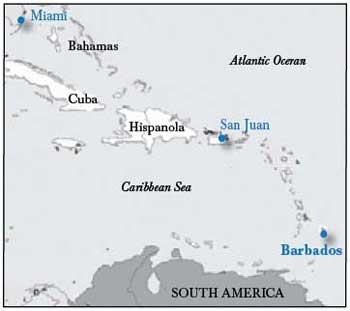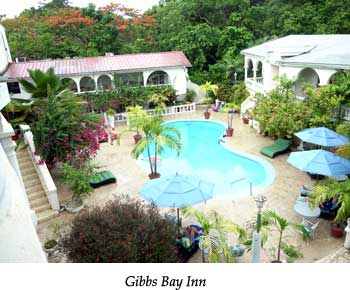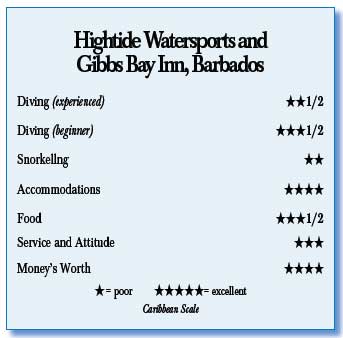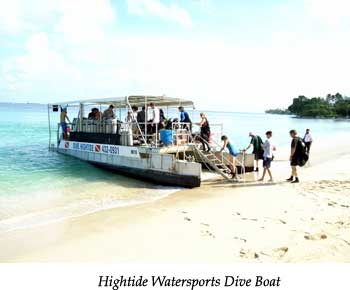Hightide Watersports and Gibbs Bay Inn, BarbadosContents of this Issue: Hightide Watersports and Gibbs Bay Inn, Barbados Bonaire, Fiji, Galapagos, Roatan American Left Not Far Behind by an Australian Dive Boat I Can See Clearly Now ... Underwater Want Lower Baggage Fees? Book Through a U.S. Dive Travel Agency Thumbs Down: Wakatobi’s Bad Behavior Editorial Office: Ben Davison Publisher and Editor Undercurrent 3020 Bridgeway, Suite 102 Sausalito, CA 94965 and a word from Ben Davison from the September, 2011 issue of Undercurrent
I received an email from Scuba Diving magazine last month that touted the "Planet's Ten Top Shore Diving Destinations." Did you know that Oahu, Orange County and St. Thomas are in the top ten in the whole wide world? Two legit destinations were Indonesia and the Philippines, both of which have infinitely more diveable shorelines than the three I mentioned. To add insult, UNEXSO in the Bahamas is listed as among the world's best diving and resorts, though it's not a resort, and aside from the shark circus they run, diving is pedestrian. I suppose I should thank Scuba Diving (and for that matter, Sport Diving), because such balderdash has kept Undercurrent in business for nearly 40 years. You see, smart divers recognize the integrity we bring to the table. Financially, it's not easy, but we keep our anonymity when we review resorts by never announcing our purpose. Our writers pay their own airfares, diving and accommodations, and we don't take advertisements in our publication. It's a different story at the magazines, which, in addition to the paid advertising, have their expenses of writers, photographers and toadies covered completely. But that's their business and not ours, so we are grateful to write for the savvy divers who know fact from fiction and stick with us. Truth is, the Undercurrent family takes great pride in slouching around dive operations to prepare truthful and insightful reports on everything from reef quality to dinner quality, from clean galleys to clean heads, from sensible group leaders to insensitive divemasters. We report our full experience, leaving nothing out. It's as if you were there.
A coupple of complaints I received recently comes from divers who are with a group of non-divers and want to go to a true vacation island - and that's not Cayman, Bonaire or Cozumel, unless you're a diver. I've made it a point every couple of years to cover such places, so in this issue we're covering Barbados, where years ago I found some remarkably decent diving (and 19th century bottles) on an island that American divers never give much attention. If it's not your cup of tea, coming in the next few issues will be liveaboard journeys in Indonesia, land-based trips in the Philippines, and who knows where else. Also, in later pages of this issue, you'll get an update on Wananavu, where diving seemed shaky when Ra Divers departed, and plenty of other distant places with -- believe me -- better shore diving than Orange County or Oahu. * * * * * Dear Diver, The time comes in every diver's life when he must at least once vacation to a nondiving destination to please the family. Barbados, I discovered, fills the bill -- and you can get a few decent dives as well. If the white sand beaches don't impress you, then the palms swaying in the breeze flanked by colorful blooming trees surely will. By Caribbean standards, Barbados is likely one of the better destinations for beginning and intermediate divers, having a large number of small tropical fish, colorful hard corals, and gigantic sea plumes, much black coral, even a big wreck. When I went in July, water was a consistent 83 degrees, and on land, it was usually in the mid 80s.
Brightly colored hard corals were the norm on most dives. Fisherman's Reef was especially pretty, with some of the tallest, standing 10 to 12 feet, and the fullest sea plumes I've encountered, juxtaposed with nearby coral "faerie castles." Juvenile and adult spotted drum added to the drama. Spotted morays peered out as I slowly explored, accompanied by a plethora of small tropicals. Visibility was a clear 70 feet. The next day we returned to the other side of this reef. Tropical fish were again plentiful, and I spotted a conger eel, many blue and yellow trumpetfish, and butterflyfish "kissing." I was also rewarded by finding two very old wine bottles (more about that later). The divemasters claimed that Bright Ledge Reef was the prettiest dive on Barbados, but even with the two turtle sightings, I thought it came in second to Fisherman's.
Of the many wrecks off of Barbados' west coast, the 365-foot-long freighter S.S. Stavronikita, resting at 130 feet, was the most impressive. After 30-plus years, undersea life nearly envelopes her, especially the masts; colorful sponges particularly abound. Kicking along hallways peering into cabins was no problem with a flashlight, and it was never fully dark. Penetration was easy, as the fittings on which divers could get hung up have been stripped. Visibility was around 50 feet. As a safety precaution, boat crew attached one tank to the boat at a depth of 15 feet, and a divemaster carried another. The current was usually a half-knot at most, hardly noticeable. There were many new divers on board, and two newly certified who had a quick lesson in diving current on Bell Buoy Reef. On board, the divemasters said there might be some surface current that would diminish with depth, but the dive would be treated as a drift dive. I hit the water and immediately lost sight of my dive buddy as I rocketed to the bottom at 54 feet, where the current was still strong. It took me five minutes of swimming into the current to locate my dive buddy, who had a camera with large strobes in tow; he was partially sheltered in a sandy recess between shallow coral heads. We waited another 10 minutes until we spotted a divemaster and other divers. The remaining 20 minutes was spent finning hard into the current, as buddy teams surfaced with low air or exhaustion. Certainly no drift dive. On several dives with sandy patches, the hunt for 150-year-old wine bottles seemed more important to some divers than the fish. Bumbass Reef, Jolly Roger, Church Point and to a lesser extent, Carlisle Bay, revealed a few each -- not nearly the numbers I've heard were found a couple decades ago. I left the wine bottles I found in the sand, even though the divemasters on the boat shrugged when asked about the policy. In my mind, the few that are discovered these days deserve to be left to delight other divers, but one in my group coveted his find and returned home with it. This experienced diver is the same one who intentionally agitated a ballonfish until it inflated, and was hands-on with other sea life.
After the first day when we put gear onto the tanks, Hightide Watersports did the handling, from rinsing back at their shop to setting it up again. Divemasters and the boat captain and were well versed on sea life and the sites, attentive, friendly, and their sense of humor never flagged. One thing they could not control was the hot dogs on jet skis, who reveled in seeing how close they could come to the dive boat, ignoring attempts at waving them off. (It is not safe to snorkel except in the marine parks unless you carry a marker buoy, and I'm not sure how safe that would make you in the eyes of possibly rum-fueled jetskiers). It is easy and cheap to get around the island, as frequent buses barrel over the two-lane roads and charge US$1, whether you are going a block or all around the island. Food is expensive, so I ate at the low-end range. My favorite was the East Moon Chinese restaurant, a tricky, 20-minute walk from Gibbs Bay Inn as sidewalks tended to be sparse. The won-ton soup was nicely flavored with four fat wontons. Entrées averaged $15, with a lunch special for $7.50. Ramshackle, on the beach, was a divers' favorite. Barbados is an ideal spot for a family vacation, especially when there are nondivers. It is one of the few Caribbean islands with a large variety of well-developed possibilities, so you don't have to feel guilty about diving. One 20-something man from our group, there with his parents, put together a vigorous day of bodyand windsurfing on the windward side, then went farther south for kiteboarding. The less energetic strolled through the botanical gardens or visited Harrison's Cave, which is a winner for all ages; a tram makes it an easy view of the stalactites and stalagmites. Another family wanted to zip-line, also popular in Barbados, but after making an appointment the day before and taking a cab there ($40), they found it closed. White sand beaches just go on and on, welcoming the beachcomber or picnicker. You can find great restaurant and hotels in all price ranges (the legendary Sandy Lane can run you more than $1,000 a night), but it's a good idea to get accommodations near your activities of choice. Barbados is a big and busy island. Whatever you do, just relax, you cannot push the Caribbean timetable. But why should you want to? -- J.D.
|

I want to get all the stories! Tell me how I can become an Undercurrent Online Member and get online access to all the articles of Undercurrent as well as thousands of first hand reports on dive operations world-wide
| Home | Online Members Area | My Account |
Login
|
Join
|
| Travel Index |
Dive Resort & Liveaboard Reviews
|
Featured Reports
|
Recent
Issues
|
Back Issues
|
|
Dive Gear
Index
|
Health/Safety Index
|
Environment & Misc.
Index
|
Seasonal Planner
|
Blogs
|
Free Articles
|
Book Picks
|
News
|
|
Special Offers
|
RSS
|
FAQ
|
About Us
|
Contact Us
|
Links
|
3020 Bridgeway, Ste 102, Sausalito, Ca 94965
All rights reserved.

 One problem is that we can't send someone to every destination.
We have a stable of diver/writers who spend their own
money, go where they want, and ask if I want a story. I pick
and choose from what they offer, and from time to time I fill
in the spots they miss. I think we have done a balanced job
in covering the planet, especially by supplementing our major
reviews with insights from our experienced readers. While a
surprising number fly off to Papua New Guinea, Indonesia or
the Maldives for weeks at a time, about two-thirds of our readers stick much closer to home -- the
Caribbean, Mexico, Florida and Hawaii, for
example. Groups, solo divers and divers with
a non-diving spouse, buddy pairs, tech divers,
highly experienced divers, some newbies,
and families look to us for advice. Quite a
wide range to please.
One problem is that we can't send someone to every destination.
We have a stable of diver/writers who spend their own
money, go where they want, and ask if I want a story. I pick
and choose from what they offer, and from time to time I fill
in the spots they miss. I think we have done a balanced job
in covering the planet, especially by supplementing our major
reviews with insights from our experienced readers. While a
surprising number fly off to Papua New Guinea, Indonesia or
the Maldives for weeks at a time, about two-thirds of our readers stick much closer to home -- the
Caribbean, Mexico, Florida and Hawaii, for
example. Groups, solo divers and divers with
a non-diving spouse, buddy pairs, tech divers,
highly experienced divers, some newbies,
and families look to us for advice. Quite a
wide range to please. Even so, diving can be a hassle. Hightide Watersports' 37-foot aluminum catamaran
sunk low at the buoy with 24 divers on board. After a detailed briefing, I struggled
for space to shrug into my BC in the tight quarters to avoid being bumped around --
divers and tanks were squeezed together like canned sardines. I was one of the first
in the water, but it took 10 minutes for everyone else to follow; no problem for me,
as I like longer dives. When half the group was at depth, one of the two divemasters
headed out for 60 minutes, usually less. Forty-minute dives were the average,
timed by the last person entering. When we were in Carlisle Bay, a small shallow area
with six partial wrecks positioned near each
other, I asked if I could go ahead. "No, you
might get lost," was the reply. He was serious!
I shrugged and waited another 20 minutes.
Indeed, two divers did become disoriented in
visibility of about 15 feet.
Even so, diving can be a hassle. Hightide Watersports' 37-foot aluminum catamaran
sunk low at the buoy with 24 divers on board. After a detailed briefing, I struggled
for space to shrug into my BC in the tight quarters to avoid being bumped around --
divers and tanks were squeezed together like canned sardines. I was one of the first
in the water, but it took 10 minutes for everyone else to follow; no problem for me,
as I like longer dives. When half the group was at depth, one of the two divemasters
headed out for 60 minutes, usually less. Forty-minute dives were the average,
timed by the last person entering. When we were in Carlisle Bay, a small shallow area
with six partial wrecks positioned near each
other, I asked if I could go ahead. "No, you
might get lost," was the reply. He was serious!
I shrugged and waited another 20 minutes.
Indeed, two divers did become disoriented in
visibility of about 15 feet. My group stayed at a charming bed and
breakfast, the Gibbs Bay Inn in St. Peters
Parish. A beautiful sandy beach was a short
walk away, through a "private access" pathway
framed by arched wooden doors, where
the dive boat picked us up daily at 8:30
a.m. The inn is being refurbished, after
years of disuse, by English couple Toby
and Karen Syson, who were most accommodating.
The somewhat whimsical mansion, with
its columns and arches, was remodeled by
Oliver Messel, an English architect best known for designing theatre sets, masks and
costumes, camouflaging pill boxes in WWII, and designing and remodeling unique homes
in Barbados and Mustique. There are many nooks for lounging near the alcoves of the
25 rooms. Sitting around the pool at the end of a day is the epitome of relaxation.
An adjacent room held the honor bar -- a refrigerator full of the local Banks beer,
water and sodas, and bottles of liquor were set out. Wine was US$3 -- you pour -- and
beer $2.50. Hearty breakfasts were served on white lace tablecloths in the open-sided
gazebo by the pool. Tea was laid at 4 p.m. -- hot tea, finger sandwiches and cookies
or cakes. Each day, I would forage under the mango trees along the inn's drive for the
sweet yellow fruit. All in all, an infectiously charming place at a reasonable price.
There is a heavy British influence in Barbados, as it was a colony from 1625 to 1966,
when independence was granted by Queen Elizabeth.
My group stayed at a charming bed and
breakfast, the Gibbs Bay Inn in St. Peters
Parish. A beautiful sandy beach was a short
walk away, through a "private access" pathway
framed by arched wooden doors, where
the dive boat picked us up daily at 8:30
a.m. The inn is being refurbished, after
years of disuse, by English couple Toby
and Karen Syson, who were most accommodating.
The somewhat whimsical mansion, with
its columns and arches, was remodeled by
Oliver Messel, an English architect best known for designing theatre sets, masks and
costumes, camouflaging pill boxes in WWII, and designing and remodeling unique homes
in Barbados and Mustique. There are many nooks for lounging near the alcoves of the
25 rooms. Sitting around the pool at the end of a day is the epitome of relaxation.
An adjacent room held the honor bar -- a refrigerator full of the local Banks beer,
water and sodas, and bottles of liquor were set out. Wine was US$3 -- you pour -- and
beer $2.50. Hearty breakfasts were served on white lace tablecloths in the open-sided
gazebo by the pool. Tea was laid at 4 p.m. -- hot tea, finger sandwiches and cookies
or cakes. Each day, I would forage under the mango trees along the inn's drive for the
sweet yellow fruit. All in all, an infectiously charming place at a reasonable price.
There is a heavy British influence in Barbados, as it was a colony from 1625 to 1966,
when independence was granted by Queen Elizabeth. Two small marine parks are marked where
there is neither fishing nor speeding boats -
- tiny areas by most Caribbean dive island
standards. In Barbados, fishermen won dominance
over marine life. "After all, it's their
livelihood," one dive operator told me. As a
result, most fish seen on dives are small, but
there were plenty of tropical species. (Other
species of particular interest to me on several
sites were whitenose pipefish, web burrfish,
spotted scorpionfish and a dozen turtles of varying sizes.) Shore snorkeling was poor,
due to heavy algae within the first 300 yards. Fish were scarce in those areas, and
visibility was poor.
Two small marine parks are marked where
there is neither fishing nor speeding boats -
- tiny areas by most Caribbean dive island
standards. In Barbados, fishermen won dominance
over marine life. "After all, it's their
livelihood," one dive operator told me. As a
result, most fish seen on dives are small, but
there were plenty of tropical species. (Other
species of particular interest to me on several
sites were whitenose pipefish, web burrfish,
spotted scorpionfish and a dozen turtles of varying sizes.) Shore snorkeling was poor,
due to heavy algae within the first 300 yards. Fish were scarce in those areas, and
visibility was poor. Divers Compass: Seven nights at Gibbs Bay Inn, five days of twotank
diving with Hightide Watersports and air transportation cost me
$2,024; for the non-divers, it was $1,649 . . . Rooms at Gibbs Bay
Inn did not have TVs or radios, but a kitchen with fridge was available
in the alcoves; full kitchens with stoves were available to
guests in several areas, as well as a large propane grill near the
pool area . . . Hightides has two boats, for 13 and 25 divers, and
can provide for the most divers in Barbados ; other dive operations
hire out . . . Websites:
Divers Compass: Seven nights at Gibbs Bay Inn, five days of twotank
diving with Hightide Watersports and air transportation cost me
$2,024; for the non-divers, it was $1,649 . . . Rooms at Gibbs Bay
Inn did not have TVs or radios, but a kitchen with fridge was available
in the alcoves; full kitchens with stoves were available to
guests in several areas, as well as a large propane grill near the
pool area . . . Hightides has two boats, for 13 and 25 divers, and
can provide for the most divers in Barbados ; other dive operations
hire out . . . Websites: 